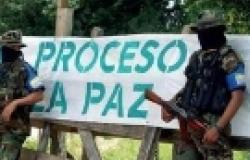Book Review: Organized Violence after Civil War: The Geography of Recruitment in Latin America

Organized Violence after Civil War: The Geography of Recruitment in Latin America by Sarah Zukerman Daly. New York: Cambridge University Press, 2016. 315 pp, £64.99 hardcover 978-1-107-12758-6, £20.99 paperback 978-1-107-56683-5
Nearly half of the countries emerging from civil war relapse into conflict a few years after signing a peace agreement. Building peace is a complex and long-term task and research shows that many post-conflict societies experience different manifestations of insecurity and instability, including in some cases a resumption of war. In Colombia, different peace processes have been conducted with rebel and paramilitary groups in recent decades. This book examines in detail the demobilization of paramilitary groups in the 2000s and the reasons why some of those groups effectively demilitarized while others were willing and able to remilitarize. The focus on group trajectories is an innovative and promising approach with the potential to illuminate factors behind the perpetuation of violence, not just in Colombia.
Sarah Zukerman Daly, of the University of Notre Dame, analyses the 37 right-wing militias grouped under the collective ‘umbrella’ of the United Self-Defense Forces of Colombia (AUC) that signed an agreement with the Government of President Alvaro Uribe and undertook demobilization between 2003 and 2006. They did so at the height of their power and transitioned through different stages. In 2006, these powerful armies had been decommissioned.
In the next five years, roughly half of the groups fully remilitarized. They reenlisted their fighters and rebuilt their command and control structures, while the other half demilitarized. Some of them passed through a period of “silenced guns” and transformed into sociopolitical entities and NGOs, retaining high levels of coercion capacity and control over former fighters and populations, but without the resort to overt violence. The author seeks to explain the reasons behind these different post-war trajectories.
The author demonstrates that the primary driving force is the recruitment pattern within and among groups. Networks and geography are more important than access to weapons, which is almost universal. Groups that recruit and deploy forces locally tend to have better information about the environment and their relative power vis-a-vis other armed groups and official forces, and are likely to stay in the same place after demobilization thus retaining their social networks. When they choose to remilitarize, they are more capable of doing so effectively. Meanwhile, groups that recruit nationally have less information, face more uncertainty and are likely to disband after an agreement. Uncertainty can push them towards remilitarization, but their effectiveness will be limited.
 In Chapter 2 Daly develops in detail the proposed theory and causal process. She describes here how the geography of recruitment affects the networks and cohesion within an armed organization, and how variation in recruitment patterns among organizations causes some organizations to demilitarize and others to fight. She also presents the research design and the sources used to develop this project. Chapter 3 examines the origins and evolution of the Colombian paramilitary groups, and three research questions: why these powerful groups decided to join negotiations, why they signed peace agreements that lacked guarantees of implementation, and why non-local units (groups deployed far from the geographical origins of their members) agreed to demobilize despite knowing that the group would be weakened thus.
In Chapter 2 Daly develops in detail the proposed theory and causal process. She describes here how the geography of recruitment affects the networks and cohesion within an armed organization, and how variation in recruitment patterns among organizations causes some organizations to demilitarize and others to fight. She also presents the research design and the sources used to develop this project. Chapter 3 examines the origins and evolution of the Colombian paramilitary groups, and three research questions: why these powerful groups decided to join negotiations, why they signed peace agreements that lacked guarantees of implementation, and why non-local units (groups deployed far from the geographical origins of their members) agreed to demobilize despite knowing that the group would be weakened thus.
In Chapter 4, the author explores the geography of recruitment in Colombia and its influence on structures and cohesion. Using data on more than 35,000 fighters, and geocoding to estimate the post-war dispersion of the fighters, the author traces the combatants’ prewar and postwar social connections and mutual dependence. The data shows a strong relationship between an armed group’s geography of recruitment and its postwar organizational capacity. In Chapter 5, multiple sets of data are used to conduct statistical analysis and explore the regional configuration of the armed groups, and how their recruitment patterns influenced their demilitarization and remilitarization. The theory is tested against rival explanations derived from the literature on war outcomes and the political economy of violence.
Chapters 6 and 7 cover in-depth case studies of post-war transitions. The process of demilitarization was not linear for some of the groups. “Armed organizations do not transition from militarized to completely demilitarized overnight; rather, it is a process” (p. 114), during which they retain control and influence over the civilian population although their guns are silenced or muted. This was the case of Bloque Cacique Nutibara, that kept control over Medellin neighborhoods, mainly through the NGO created by them, Corporacion Democracia. The fact that most combatants were locals allowed them to stay in the same areas once demobilized and to be accepted by the communities. 93% of the Cacique paramilitary members remained in Medellin and the surrounding areas after demobilization, and this “sustained collective action and enabled the organization’s structure to endure and to maintain its power” (p. 145).
Chapter 7 studies groups that remilitarized, either strongly or weakly. Most combatants of the Bloque Catatumbo had been recruited far from their areas of deployment and transplanted to Norte de Santander. They relied on local networks for inputs such as information, food, transportation, and accommodation. After demobilization, most combatants dispersed across Colombia. Most top commanders left the region creating a vacuum in the command structure. Those who chose to remain had limited access to information from the civilian populations after demobilization. “Demobilization shocked and downgraded the Bloque Catatumbo’s capacity” (p. 181). Even though they tried to remilitarize, this attempt was weak and did not last.
In Chapter 8, the author discusses the possibilities and challenges to test this theory in other cases, both in Colombia and elsewhere, while the final chapter reflects on the impact of the theory in the study of transitions from war to peace and state-building, and the policy implications for practitioners engaged in conflict resolution efforts. After analyzing the potential and shortfalls in attempts to engage in the process of disarmament, demobilisation and reintegration (DDR) by international actors, Daly suggests that “tracking the armed units' recruitment geographies and understanding the impacts that different policies are likely to have on these units' physical clustering, social networks, and territorial power would be a valuable first step toward designing policies that would do more good than harm” (p. 255).
A remarkable aspect of this book is the rigorous research design and thorough fieldwork that includes hundreds of interviews with former members and commanders of the paramilitary groups, national and regional institutions, civil society, and victims of those groups, among other sources. The author also used information from public forces and international organizations to construct databases and conducted surveys over a 10-year period. She presents the results in statistical format, in tables and maps, and conducts in-depth case studies of selected militias to deepen the understanding of the findings. A detailed appendix for each chapter, and an extensive bibliography, analytical index, maps, graphics, and tables complete the robustness of this piece. Every scholar or policy-maker interested in the evolution of armed groups in contemporary armed conflicts should be aware of this book.
Mabel González Bustelo is an international advisor and consultant in peace and security, Contributor Analyst to Wikistrat, and former Fellow of the Global South Unit for Mediation (BRICS Policy Centre, Brazil). @MabelBustelo


